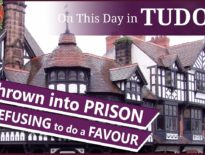On this day in Tudor history, 14th December 1542, six-day-old Mary, daughter of King James V and his second wife, Marie de Guise, became Queen of Scotland – Mary, Queen of Scots.
King James V, who had ruled since 1513, was just 30 at his death.
Find out what happened to James V, and how Mary became queen at such a young age, in today's talk.
Here is the video I mentioned on King James V:
And the Mary, Queen of Scots playlist:
Also on this day in Tudor history, 14th December 1558, Queen Mary I was buried at Westminster Abbey. Mary had died on 17th November 1558 and had left instructions for Catherine of Aragon's remains to be moved from Peterborough and for them to be reinterred with Mary's remains so that mother and daughter could be together. Did this happen? Find out in last year’s video:
Also on this day in history:
- 1562 – Death of William Grey, 13th Baron Grey of Wilton and military commander, during the night of 14th/15th December at the home of his son-in-law, Henry Denny, at Cheshunt in Hertfordshire. Grey served as a commander in the expedition to France in 1544, as Field-Marshal and Captain-General of Horse in Scotland in 1547, as a soldier in France in 1557, and as Warden of the Eastern and Middle Marches in 1559.
- 1563 – Baptism of Thomas Belson, Roman Catholic martyr, at Aston Rowant Church in Oxfordshire. He was hanged on 5th July 1589 for assisting the Catholic priests, George Nichols and Richard Yaxley, who were hanged, drawn and quartered on that day.
- 1563 – Burial of William Dacre, 3rd Baron Dacre of Gilsland and 7th Baron Greystoke, at Carlisle Cathedral.
- 1585 – Burial of Thomas Bentley, editor of “The Monument of Matrones: Conteining Seven Severall Lamps of Virginitie, or Distinct Treatises; Whereof the First Five Concerne Praier and Meditation: the Other Two Last, Precepts and Examples” (1582), a collection of prayers and meditations for and by women. It is said to be the first published anthology of English women's writing. Bentley was buried at St Andrew's, Holborn.
- 1592 – Death of Sir Roger Manwood, judge, member of Parliament and Elizabeth I's Lord Chief Baron of the Exchequer, in St Stephen's Parish, Hackington, near Canterbury.
- 1593 – Death of Henry Radcliffe, 4th Earl of Sussex, soldier, member of the Irish Privy Council, member of Parliament and patron of the Earl of Sussex's men. He was buried at Boreham in Essex.
- 1595 – Death of Henry Hastings, 3rd Earl of Huntingdon, administrator, diplomat, and military commander, at York. He was buried at St Helen's Church, Ashby-de-la-Zouch. Huntingdon was educated with the young Edward VI, and served in the household of Cardinal Reginald Pole, his great-uncle. He served Elizabeth I as President of the Council of the North, and was one of the peers at the trial of Mary, Queen of Scots in 1586.
- 1624 – Death of Charles Howard, 2nd Baron Howard of Effingham and 1st Earl of Nottingham, at Haling in Surrey. He was buried at Reigate Church in the family vault. Nottingham served Elizabeth I and James I as Lord High Admiral, and commanded the English forces against the Spanish Armada in 1588.
Transcript:
On this day in Tudor history, 14th December 1542, six-day-old Mary, daughter of King James V and his second wife, Marie de Guise, became Queen of Scotland – Mary, Queen of Scots.
By the time of his death, thirty-year-old King James V of Scotland, son of Margaret Tudor and King James IV, had ruled Scotland for 29 years. Like his daughter, he’d become monarch when his father was killed at the Battle of Flodden on 9th September 1513, a battle against the forces of Henry VIII, Margaret Tudor’s brother. He’d been crowned on 21st September 1513 at Stirling Castle when he was just seventeen months old. I’ll give you a link to my video on his life, so that you can find out all about his life and reign.
War had broken out between Scotland and England in the summer of 1542, when Henry VIII had made an alliance with Emperor Charles V against France. Scotland and France were old allies, so Henry sent men to the Scottish borders to prepare for war. On 24th August, the Scots defeated the English at the Battle of Haddon Rig, so Henry sent seasoned soldier and leader Thomas Howard, 3rd Duke of Norfolk, the man who’d commanded the troops so successfully at Flodden, to command English troops again.
In November 1542, James decided to divide force into two, mustering one force with Robert, Lord Maxwell, at Lauder, and putting the Earl of Moray in charge of one at Haddington. James stationed himself at Lochmaben Castle and wasn’t present on 24th November 1542, when Lord Maxwell led a force of between 15,000 and 18,000 against a much smaller English force, numbering about 3,000, led by Sir Thomas Wharton. The two sides met on the edge of a salt marsh at Solway Moss and the English routed the Scots. Some Scots died of drowning in the marshes and river, and many hundreds were taken prisoner by the English.
On hearing the news of the resounding Scots defeat, a depressed King James V returned to Edinburgh to speak to his council and organise further raids against the English. He was taken ill with a fever in the second week of December, and by 12th December he’d taken to his bed at Falkland Palace. While he was ill, on 8th December 1542, his wife, Marie de Guise, gave birth to a daughter, Mary.
On the morning of this day in history, 14th December 1542, the dying king appointed his wife, Marie, Cardinal Beaton, and the earls of Moray, Huntly and Argyll, as joint tutors and governors to his infant daughter when she became queen and until she reached her majority. James V died later that day, passing the throne to his little girl, Mary.
John Knox and the chronicler Robert Lindsay of Pitscottie both recorded that James uttered the words “it came wi a lass, it'll gang wi a lass” (“it came with a lass, it will end with a lass”) as he lay dying, referring to how the Stuart dynasty began with a girl, through Marjorie Bruce, Robert the Bruce’s daughter, and how he feared it would now end with his daughter, Mary. However, the Stuart dynasty actually ended with another girl, Queen Anne, in 1714, and it is not known that James actually ever said these words.
James was buried at Holyrood Abbey in Edinburgh on 8th January 1543.
James’s daughter Mary was Queen of Scotland until 24th July 1567, when she was forced to abdicate in favour of her son, James, who became King James VI of Scotland at the age of just one. Mary was executed as a traitor in England in 1587 after being found guilty of conspiring against Queen Elizabeth I. Her son succeeded Elizabeth to the English throne as King James I after Elizabeth’s death in March 1603.



Leave a Reply